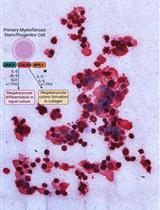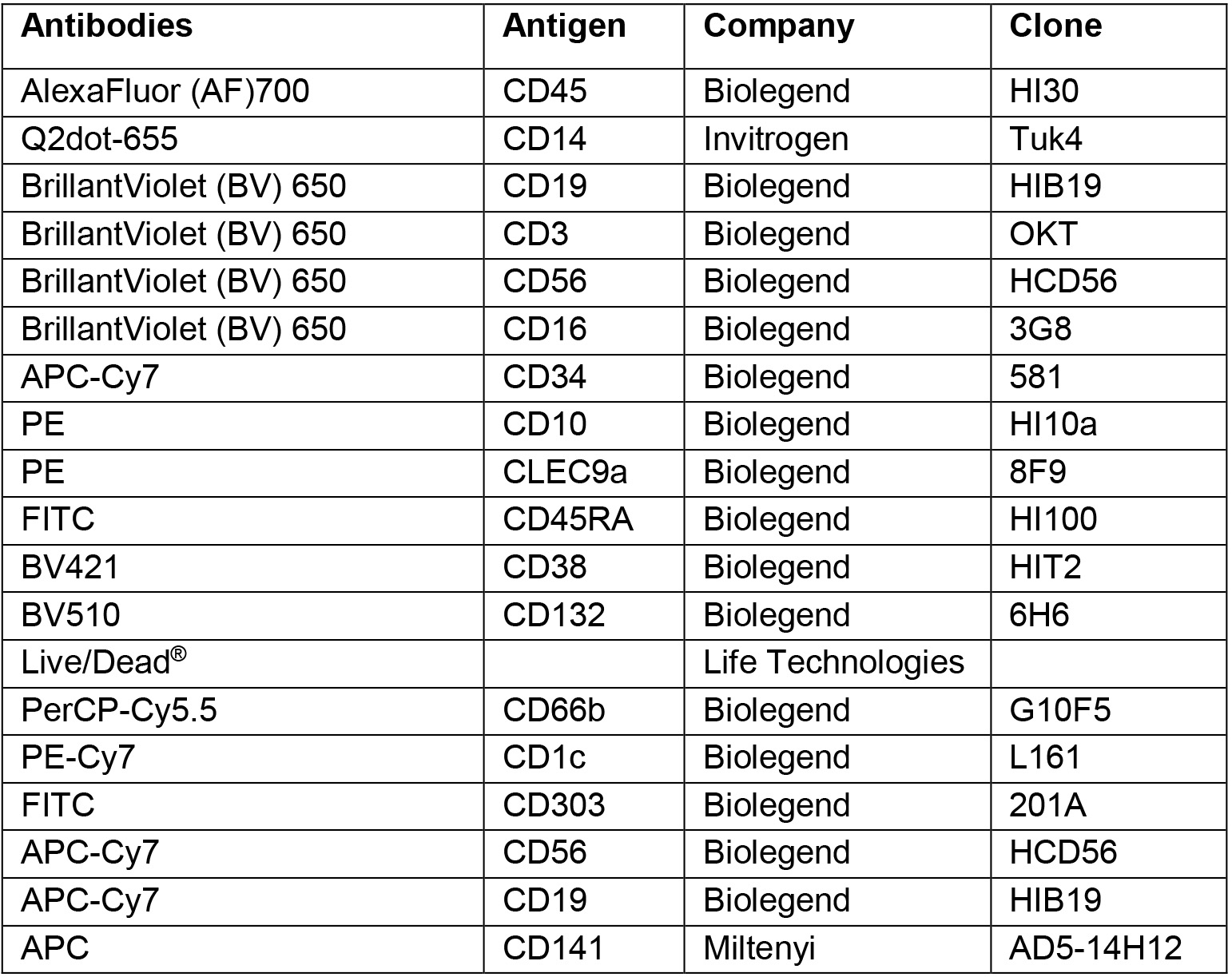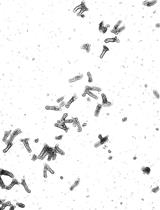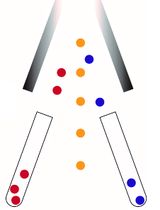- EN - English
- CN - 中文
High Dimensional Functionomic Analysis of Human Hematopoietic Stem and Progenitor Cells at a Single Cell Level
人造血干细胞和祖细胞在单细胞水平上的高维功能组学分析
发布: 2018年05月20日第8卷第10期 DOI: 10.21769/BioProtoc.2851 浏览次数: 8504
评审: Ruth A. FranklinLokesh KalekarChris Tibbitt

相关实验方案

来自骨髓增生性肿瘤患者的造血祖细胞的血小板生成素不依赖性巨核细胞分化
Chloe A. L. Thompson-Peach [...] Daniel Thomas
2023年01月20日 2346 阅读
Abstract
The ability to conduct investigation of cellular transcription, signaling, and function at the single-cell level has opened opportunities to examine heterogeneous populations at unprecedented resolutions. Although methods have been developed to evaluate high-dimensional transcriptomic and proteomic data (relating to cellular mRNA and protein), there has not been a method to evaluate corresponding high-dimensional functionomic data (relating to cellular functions) from single cells. Here, we present a protocol to quantitatively measure the differentiation potentials of single human hematopoietic stem and progenitor cells, and then cluster the cells according to these measurements. High dimensional functionomic analysis of cell potential allows cell function to be linked to molecular mechanisms within the same progenitor population.
Keywords: CD34+ hematopoietic stem and progenitor cells (CD34+造血干细胞和祖细胞)Background
The development of techniques for single-cell measurements of cell transcription, signaling, and function at the single-cell level, alongside preexisting technologies such as flow cytometry, has allowed new lenses to examine complex, heterogeneous populations. Such methods generate large amounts of data, which can be interpreted with aid from dimensionality reduction algorithms, as illustrated on single-cell RNA-Seq using Mpath, Monocole, PCA, Wishbone, or diffusion map algorithms (Paul et al., 2016; See et al., 2017), and on CyTOF using tSNE or PhenoGraph (Amir el et al., 2013; Levine et al., 2015).
We developed this protocol to allow functional analysis and subsequent dimension reduction of large-scale culture of hematopoietic progenitors in single-cell environments. In this protocol, we describe a method to culture single cells of human CD34+ hematopoietic stem and progenitor cells (HSPCs) in a stromal cell culture with cytokines, to enumerate the clonal outcome (functionomics) of six different lineages (i.e., granulocyte, monocyte, lymphocyte, CD141+ dendritic cell (conventional type 1 DC (cDC1)), CD1c+ dendritic cell (conventional type 2 DC (cDC2)), and plasmacytoid dendritic cells (pDC)) from each progenitor, and to cluster the progenitors according to function with a dimension reduction method. In our previous paper, we showed that this is feasible for a population of 2,247 progenitors; each progenitor can be individually plotted to form a two-dimensional ‘map’ of 2,247 data points (Lee et al., 2017). Our protocol allows for the functional clustering of single cells. Such high dimensional functionomic analysis aids in linking cell function to molecular mechanism of any given cell population.
Materials and Reagents
- 15 cm culture plates (Corning, Falcon®, catalog number: 353025 )
- 15 ml Falcon tubes (Corning, Falcon®, catalog number: 352097 )
- 96-well V-bottom plates (Thermo Fisher Scientific, Thermo ScientificTM, catalog number: 249570 )
- Flat-bottom 96-well plates (Corning, Falcon®, catalog number: 353072 )
- 50 ml Falcon tubes (Corning, Falcon®, catalog number: 352098 )
- Serological pipettes (Fisher Scientific, catalog number: 13-678-11 )
- Opaque Eppendorf tubes (CELLTREAT Scientific Products, catalog number: 229437 )
- Eppendorf tubes (Fisher Scientific, catalog number: 05-408-129 )
- Pipette tips
- Pasteur pipette (Fisher Scientific, catalog number: 13-678-8B )
- 100 μm cell strainer (Corning, Falcon®, catalog number: 352360 )
- 0.20 μm filter (Corning, catalog number: 431229 )
- MS5 (Lee et al., 2015a and 2015b)
- OP9 (Lee et al., 2015a and 2017)
- dH2O (Thermo Fisher Scientific, InvitrogenTM, catalog number: 10977023 )
- Trypsin (Corning, catalog number: 25-052-CI )
- Trypan blue (Thermo Fisher Scientific, GibcoTM, catalog number: 15250061 )
- 70% ethanol
- Ficoll-Paque Plus (GE Healthcare, catalog number: 17144002 )
- Anti-human CD34 MACS microbeads (Miltenyi Biotec, catalog number: 130-046-702 )
- Recombinant human Flt3L (Celldex Therapeutics, catalog number: CDX-301 )
- Recombinant human SCF (PeproTech, catalog number: 300-07 )
- Recombinant human GM-CSF (PeproTech, catalog number: 300-03 )
- Antibodies (details of clone name, fluorochrome, manufacturer and dilution are listed in Tables 1 and 3)

- MEMα with deoxyribonucleosides (Thermo Fisher Scientific, GibcoTM, catalog number: 12571071 )
- Fetal bovine serum (FBS) (Thermo Fisher Scientific, GibcoTM, catalog number: 10437028 )
- Pen-Strep (Thermo Fisher Scientific, GibcoTM, catalog number: 15140122 )
- Mitomycin C (Sigma-Aldrich, catalog number: M4287-5X2MG )
- Dulbecco’s phosphate-buffered saline (DPBS) (GE Healthcare, catalog number: SH30378.02 )
- Ethylenediaminetetraacetic acid (EDTA) (Corning, catalog number: 46-034-CI )
- Bovine serum albumin (BSA) (ThermoFisher, catalog number: BP1600-100 )
- FcR blocking buffer (Miltenyi Biotec, catalog number: 130-059-901 )
- CountBright Absolute Counting Beads (Thermo Fisher Scientific, InvitrogenTM, catalog number: C36950 )
- Complete MEMα medium (see Recipes)
- Mitomycin C stock (1 mg/ml) (see Recipes)
- FACS buffer (see Recipes)
- Anti-CD34 microbeads/FcR blocking mix (see Recipes)
Equipment
- Pipettes
- Incubator (Forma Scientific, model: 3354 )
- Centrifuge (Eppendorf, model: 5810 R , catalog number: 5811000320)
- Vortex with universal holder (VWR, catalog number: 97043-562 )
- Microscope
- Flow cytometer (BD, models: BD LSRII or LSRFortessaTM )
Procedure
文章信息
版权信息
© 2018 The Authors; exclusive licensee Bio-protocol LLC.
如何引用
Luh, T., Lucero, K., Ma, W., Lee, J., Zhou, Y. J., Shen, Y. and Liu, K. (2018). High Dimensional Functionomic Analysis of Human Hematopoietic Stem and Progenitor Cells at a Single Cell Level. Bio-protocol 8(10): e2851. DOI: 10.21769/BioProtoc.2851.
分类
免疫学 > 免疫细胞分化 > 造血干细胞和祖细胞
干细胞 > 成体干细胞 > 造血干细胞
细胞生物学 > 单细胞分析 > 流式细胞术
您对这篇实验方法有问题吗?
在此处发布您的问题,我们将邀请本文作者来回答。同时,我们会将您的问题发布到Bio-protocol Exchange,以便寻求社区成员的帮助。
Share
Bluesky
X
Copy link












